The Urethane Blog
Everchem Updates
VOLUME XXI
September 14, 2023
Everchem’s exclusive Closers Only Club is reserved for only the highest caliber brass-baller salesmen in the chemical industry. Watch the hype video and be introduced to the top of the league: — read more
September 10, 2020
Container Rate Records Are Shattered As US Imports Surge
by Tyler Durden Thu, 09/10/2020 – 12:50
By Greg Miller, via Freightwaves,
Just how high can Asia-U.S. West Coast spot rates go? They blew past $3,000 per forty-foot equivalent unit (FEU) in early August and have been climbing ever since. They’ve just topped $3,700. Can they reach $4,000?

No one predicted that the container industry would be doing this well, this quickly.
“We’ve been scratching our heads a lot, trying to figure out why ocean freight prices have climbed so high,” commented Eytan Buchman, chief marketing officer of Freightos, on Wednesday.
The bullish view is that import demand will continue to surprise to the upside. Ocean rates evidence a U.S. economic rebound. COVID erased demand for some products and services, but increased demand for other products. Storefront sales won’t recover, but e-commerce sales will offset storefront losses. Government support will counter shutdown fallout.
The bearish view is that the economic-fallout shoe has yet to drop. Demand for ocean container transport is being temporarily juiced by the tail end of waning government support, a switch to higher inventory levels — for both defensive and e-commerce reasons — and by bookings brought forward ahead of Chinese Golden Week (Oct. 1-7).
Another dip ahead?
Panjiva, a unit of S&P Global Market Intelligence, reported Wednesday that U.S. seaborne box imports hit an all-time monthly high in August.
The total came in at 2.71 million twenty-foot equivalent units (TEUs), up 5.9% year-on-year driven by a 14.3% surge from China.
“I find it difficult to see this situation as a permanent stable reversal given the underlying economic issues from the pandemic,” opined Lars Jensen, CEO of SeaIntelligence Consulting.
He foresees “another dip for container-shipping volumes” before “getting back on a more permanent upturn.”
According to Buchman, “Demand for ocean freight out of China is still outpacing supply [although] some of the current demand can be attributed to pre-loading ahead of the [Golden Week] break.
“The surge in volumes is leading to equipment shortages in Asia.” he continued. “Some shippers are paying premiums on top of spiking rates to guarantee containers and space. The imbalance is also putting pressure on overwhelmed U.S. ports and importers to process and return empty containers quickly.”
FreightWaves Maritime Expert Henry Byers believes volumes have peaked. “From here, volume will remain on a relatively stable decline through the end of year,” he predicted.Containers from China are flooding into California ports. (Photo: Jim Allen/FreightWaves)
Asia-US rates still soaring
The Shanghai Containerized Freight Index (SCFI) put Asia-West Coast spot rates at $3,758 per FEU for the week ending last Friday. The SCFI estimate for Asia-East Coast spot rate was $4,538 per FEU.
The Freightos Baltic Daily Index shows the same trend but slightly lower numbers. It has Asia-West Coast rates at $3,727 per FEU as of Tuesday and Asia-East Coast rates at $4,491 per FEU.
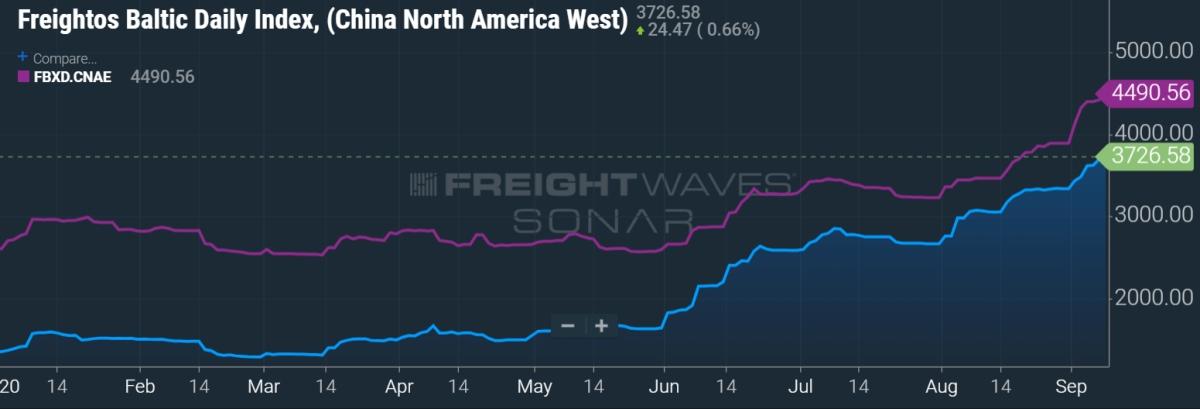
Trans-Pacific earnings ‘remarkable’
According to Alphaliner, “The recent surge in spot rates from Shanghai to California … has made this route the most lucrative for carriers for exports out of China.”
Alphaliner combined the SCFI numbers with a distance calculator to determine earnings per nautical mile for each route out of China. Shanghai-California came in at 65 cents per nautical mile, Shanghai-New York 43 cents and Shanghai-Antwerp just 20 cents.
“The fact that earnings per nautical mile are more than three times as high on the Asia-USWC [U.S. West Coast] route [versus Asia-North Europe] is remarkable, as carriers need less resources on a shorter trade,” said Alphaliner.Source: Alphaliner Weekly Newsletter; Issue 2020-36
“A typical Far East-North Europe service requires … 12 ships, whereas six ships are sufficient for a Trans-Pacific Southwest [U.S.] loop,” it noted, attributing the rate disparity to “very strong cargo demand on the trans-Pacific.”
Inactive fleet down, charter rates rebound
When coronavirus pummeled import demand in the second quarter, carriers reduced sailings. Carriers idled ships and let charters expire. They booked new charters at much lower rates. Now, carriers are scrambling to lease in as much as tonnage as they can — and they’re paying up for it.
The inactive fleet peaked at over 12% of the total fleet in late May. According to Alpahliner, it was down to just 3.4% as of Aug. 31.
Simultaneously, “the charter market continues its rapid recovery, with charter rates in many cases back to or higher than their pre-COVID-19 level,” said Alphaliner.
Ships carrying 7,500-11,000 TEUs “remain sold out.” The 5,500-7,499 TEU segment “is now sold out” after a recent fixture. Meanwhile, rates for the 4,000-5,299 TEU segment “have gone into overdrive,” said Alphaliner.
This should be welcome news for U.S.-listed container-ship leasing companies such as Costamare (NYSE: CMRE), Global Ship Lease (NYSE: GSL) and Danaos Corp. (NYSE: DAC), although their shares have yet to bounce.
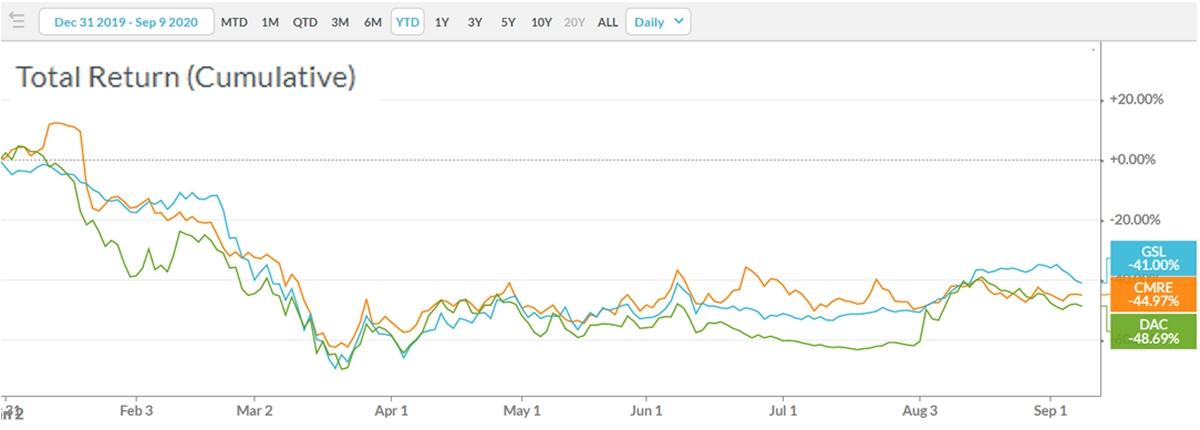
In mid-August, Stifel analyst Ben Nolan called container-ship leasing names the “single most compelling investment opportunity in traditional shipping.”
Asked by FreightWaves on Wednesday whether he still believes so, he replied, “Nothing has changed to dampen my view. The container markets have already moved and some of the [leasing] securities have not.”
Container lines run the table in Q2
With French carrier CMA CGM posting second-quarter results on Friday, all of the top 15 carriers have now reported for the period.
Sea-Intelligence analyzed each liner company’s reported earnings before interest and tax (EBIT) per TEU for the second quarter of 2020 and prior years back to 2010. Hapag-Lloyd led the pack in the latest period, with EBIT/TEU of $146, with Maersk at $129.
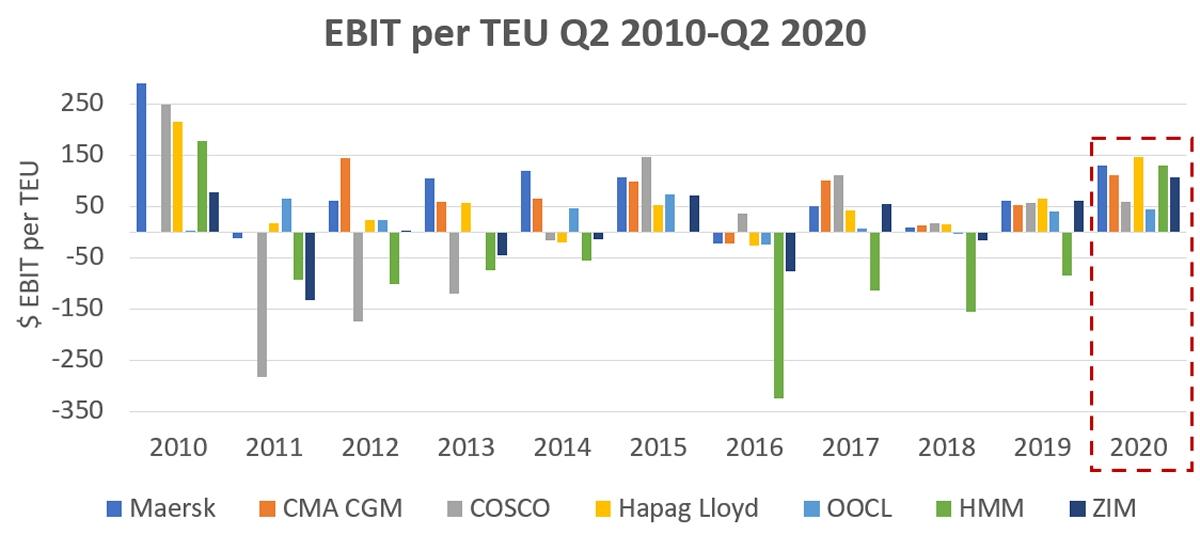
According to Sea-Intelligence CEO Alan Murphy, “A positive EBIT/TEU basically means the shipping line is making an operating profit for every TEU transported.” The second quarter of 2020 was “the first time since 2010 that all reporting carriers have had a positive EBIT/TEU,” he said.
“This is a very positive development for shipping lines,” affirmed Murphy. “The pandemic did not impact container shipping to the extent that was initially feared.” Click for more FreightWaves/American Shipper articles by Greg Miller
https://www.zerohedge.com/economics/container-rate-records-are-shattered-us-imports-surge
September 10, 2020
‘Caddyshack’ star Michael O’Keefe will caddie at 2020 US Open
September 9, 2020 | 7:54pm
Danny Noonan is going to caddie at the U.S. Open next week.
Well, kind of.
Michael O’Keefe — the actor who played Danny Noonan, the young, impressionable caddie in “Caddyshack’’ — will carry a bag on Monday and Tuesday in practice rounds at the U.S. Open, The Post has learned.
He won’t be on the bag for Ty Webb — aka Chevy Chase. Danny Balin will have to do.
And it won’t be at Bushwood Country Club. Winged Foot will have to do.
Danny will be caddying for Danny — Danny Balin, a 17-year Westchester resident who’s the head pro at Fresh Meadow Country Club on Long Island.
“Whenever I would meet someone and say, ‘I’m Danny,’ they’d go, ‘Danny, do you do drugs?’ ’’ Balin told The Post on Wednesday, mimicking one of the most iconic lines in the movie.
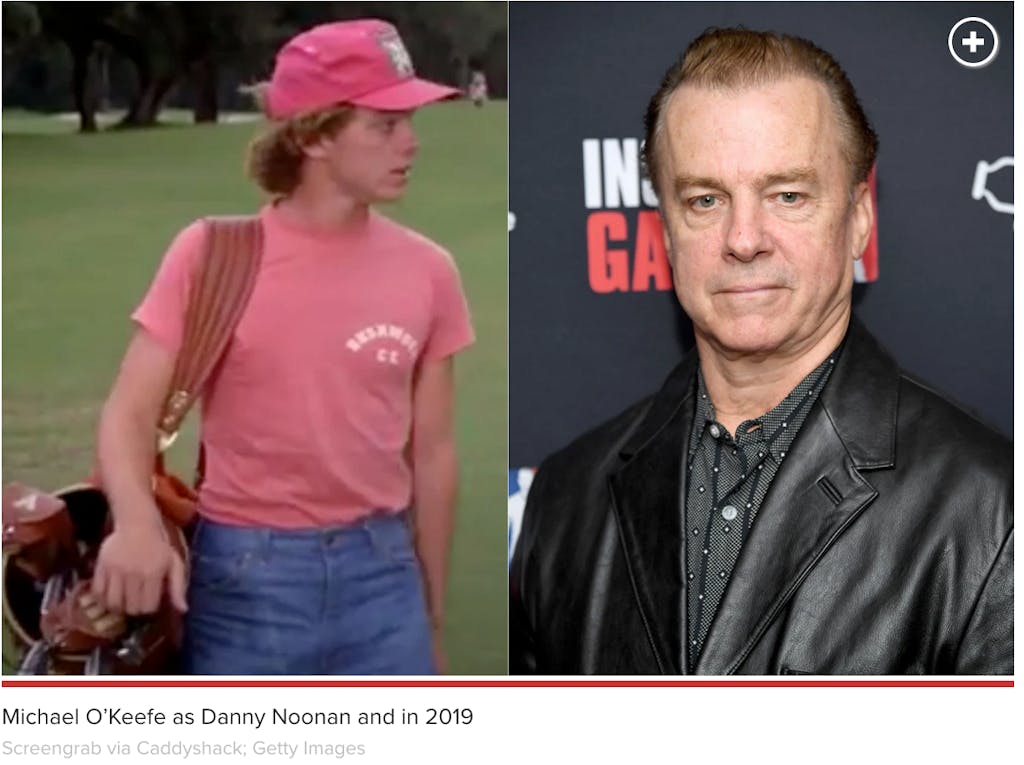
So, Danny Noonan, on the 40th anniversary of “Caddyshack,’’ has a loop at the U.S. Open. Wouldn’t Judge Smails be proud?
The whole thing began when O’Keefe, now 65 and living in Ulster County, penned a tongue-in-cheek piece for golf.com soliciting any player playing in the U.S. Open to hire him to caddie.
O’Keefe, who grew up in Larchmont, caddied at Winged Foot in 1971 and 1972, right before he went west to pursue his acting career. His brother Bill has been a longtime Winged Foot member and is a past president of the club.
“I thought, ‘What if there’ a golfer out there who’s willing to give me a shot to carry their bag?’ ’’ O’Keefe told The Post. “It’s not like I’m going to mess anybody up. I do know the course. It could be fun.’’
O’Keefe’s initial motivation in trying to land a loop was to be able to initiate a donation fund for caddie relief to aid the caddies who were out of work during the pandemic.
When asked how realistic he thought his chances were of getting a bag for the Open, O’Keefe said, “I think it’s absolutely as big a long shot as Carl Spackler winning the Masters,’’ referring to the Bill Murray character who was the mentally unstable groundskeeper in the movie.
Well, next week, O’Keefe will be on the grounds with a golf bag over his shoulder, rubbing shoulders with the likes of Tiger Woods, Phil Mickelson, Dustin Johnson and Rory McIlroy.
“In my opinion, Michael O’Keefe is not going to be able to carry a staff bag around Winged Foot,’’ Balin said with a laugh.
Asked if he plans to bring a lighter carry bag for O’Keefe next week, Balin said, “No, he’ll be carrying the full tour bag. I’m going to put him to work.’’
Balin said he DVRed “Caddyshack’’ on Tuesday night even though he estimated he’s watched the movie “15 or 20 times.’’
“I’m going to have to watch it to get the one-liners down so I can give it to him,’’ Balin said. “Because I’m going to be all over him during this whole … stunt.’’
Michael Breed, the former Golf Channel instructional personality who now teaches at Trump Ferry Point, was the middle man to this transaction, reaching out to Balin, his fellow Met Area pro, and pitching the idea of O’Keefe caddying for him.
“I try to take this somewhat serious, so I would never do this during a tournament round,’’ Balin said. “But I was like, ‘Yeah this will be cool. Danny Noonan. Monday and Tuesday.’ It’ll be a fun couple of days. It’ll lighten the mood up.’’
The USGA plans to have some fun with this, making it a social media event on its platforms.
O’Keefe revealed that he didn’t even play golf as a kid, that he “lied at the Caddyshack audition when they asked if I could play and I said, ‘Yeah.’ ’’
As soon as he got the gig, O’Keefe said he went back to Winged Woot and, with help of then head pro, Tom Nieporte, got lessons “so when I got there [to film the movie] I at least had something that resembled a golf swing.’’
Now he comes full circle, minus the powerhouse movie cast.
“I was lucky to be in the same movie with Bill Murray, Chevy Chase, Rodney Dangerfield and Ted Knight, because those guys are comic legends,’’ he said. “They were just geniuses and they were at the height of their power — all four of them. Anybody can see that all I did was just grab onto their coattails and hang on.’’
O’Keefe, though, has gone on to have an accomplished acting career, which continues today — despite the fact that he’ll forever be known as Danny Noonan.
“Actors are always pigeon-holed, and I didn’t ever have a grudge about it,’’ he said. “But there was a part of me that was like, ‘Man, I wish somebody would know me for the other work that I’ve done, too.’ ’’
September 10, 2020
‘Caddyshack’ star Michael O’Keefe will caddie at 2020 US Open
September 9, 2020 | 7:54pm
Danny Noonan is going to caddie at the U.S. Open next week.
Well, kind of.
Michael O’Keefe — the actor who played Danny Noonan, the young, impressionable caddie in “Caddyshack’’ — will carry a bag on Monday and Tuesday in practice rounds at the U.S. Open, The Post has learned.
He won’t be on the bag for Ty Webb — aka Chevy Chase. Danny Balin will have to do.
And it won’t be at Bushwood Country Club. Winged Foot will have to do.
Danny will be caddying for Danny — Danny Balin, a 17-year Westchester resident who’s the head pro at Fresh Meadow Country Club on Long Island.
“Whenever I would meet someone and say, ‘I’m Danny,’ they’d go, ‘Danny, do you do drugs?’ ’’ Balin told The Post on Wednesday, mimicking one of the most iconic lines in the movie.

So, Danny Noonan, on the 40th anniversary of “Caddyshack,’’ has a loop at the U.S. Open. Wouldn’t Judge Smails be proud?
The whole thing began when O’Keefe, now 65 and living in Ulster County, penned a tongue-in-cheek piece for golf.com soliciting any player playing in the U.S. Open to hire him to caddie.
O’Keefe, who grew up in Larchmont, caddied at Winged Foot in 1971 and 1972, right before he went west to pursue his acting career. His brother Bill has been a longtime Winged Foot member and is a past president of the club.
“I thought, ‘What if there’ a golfer out there who’s willing to give me a shot to carry their bag?’ ’’ O’Keefe told The Post. “It’s not like I’m going to mess anybody up. I do know the course. It could be fun.’’
O’Keefe’s initial motivation in trying to land a loop was to be able to initiate a donation fund for caddie relief to aid the caddies who were out of work during the pandemic.
When asked how realistic he thought his chances were of getting a bag for the Open, O’Keefe said, “I think it’s absolutely as big a long shot as Carl Spackler winning the Masters,’’ referring to the Bill Murray character who was the mentally unstable groundskeeper in the movie.
Well, next week, O’Keefe will be on the grounds with a golf bag over his shoulder, rubbing shoulders with the likes of Tiger Woods, Phil Mickelson, Dustin Johnson and Rory McIlroy.
“In my opinion, Michael O’Keefe is not going to be able to carry a staff bag around Winged Foot,’’ Balin said with a laugh.
Asked if he plans to bring a lighter carry bag for O’Keefe next week, Balin said, “No, he’ll be carrying the full tour bag. I’m going to put him to work.’’
Balin said he DVRed “Caddyshack’’ on Tuesday night even though he estimated he’s watched the movie “15 or 20 times.’’
“I’m going to have to watch it to get the one-liners down so I can give it to him,’’ Balin said. “Because I’m going to be all over him during this whole … stunt.’’
Michael Breed, the former Golf Channel instructional personality who now teaches at Trump Ferry Point, was the middle man to this transaction, reaching out to Balin, his fellow Met Area pro, and pitching the idea of O’Keefe caddying for him.
“I try to take this somewhat serious, so I would never do this during a tournament round,’’ Balin said. “But I was like, ‘Yeah this will be cool. Danny Noonan. Monday and Tuesday.’ It’ll be a fun couple of days. It’ll lighten the mood up.’’
The USGA plans to have some fun with this, making it a social media event on its platforms.
O’Keefe revealed that he didn’t even play golf as a kid, that he “lied at the Caddyshack audition when they asked if I could play and I said, ‘Yeah.’ ’’
As soon as he got the gig, O’Keefe said he went back to Winged Woot and, with help of then head pro, Tom Nieporte, got lessons “so when I got there [to film the movie] I at least had something that resembled a golf swing.’’
Now he comes full circle, minus the powerhouse movie cast.
“I was lucky to be in the same movie with Bill Murray, Chevy Chase, Rodney Dangerfield and Ted Knight, because those guys are comic legends,’’ he said. “They were just geniuses and they were at the height of their power — all four of them. Anybody can see that all I did was just grab onto their coattails and hang on.’’
O’Keefe, though, has gone on to have an accomplished acting career, which continues today — despite the fact that he’ll forever be known as Danny Noonan.
“Actors are always pigeon-holed, and I didn’t ever have a grudge about it,’’ he said. “But there was a part of me that was like, ‘Man, I wish somebody would know me for the other work that I’ve done, too.’ ’’
September 9, 2020
Watch Computer Experts Discuss the Y2K Problem in 1999
BY Chris Higgins December 31, 2016
In the late 1990s, computer nerds (myself included) were up in arms about the Y2K problem. In brief, the issue was that many computer systems used six-digit dates (two digits each for day, month, and year), which meant that when the year 2000 hit, the system might read it as 1900. That could be a big problem.
Much money, time, and computer programming was necessary to fix the Y2K Problem, and for the most part, we survived just fine. But anyone using a computer in 1999 (especially for business) was pretty concerned about keeping things clean. In this 1999 episode of Computer Chronicles, host Stewart Cheifet goes deep on the Y2K bug. Exhibit A is Cheifet’s own credit card from Shell, which expires in the year “1000.” Oops.
In this episode, Cheifet and friends dig into a bunch of actual applications that are not Y2K-safe. Perhaps the biggest problem was with spreadsheets, which often included lots of dates and date math. In this episode, a Symantec rep comes along with a tool that reviews all your Windows apps for problems. A Microsoft rep shows some Wizards (oh, the 90s) to help with Excel problems.
Have a look, and think back to a time when we were thoroughly ready to flip out on New Year’s Eve:
There’s one other notable part of this episode—the demo of Audible (now Audible.com), around the 26-minute mark. At the time, Audible was a combination web service and hardware player (basically a proto-MP3 player with poor fidelity). The player cost $200, or $99 if you committed to buying a handful of books on tape, er, digital. Amazon eventually bought Audible in 2008.
September 9, 2020
Watch Computer Experts Discuss the Y2K Problem in 1999
BY Chris Higgins December 31, 2016

In the late 1990s, computer nerds (myself included) were up in arms about the Y2K problem. In brief, the issue was that many computer systems used six-digit dates (two digits each for day, month, and year), which meant that when the year 2000 hit, the system might read it as 1900. That could be a big problem.
Much money, time, and computer programming was necessary to fix the Y2K Problem, and for the most part, we survived just fine. But anyone using a computer in 1999 (especially for business) was pretty concerned about keeping things clean. In this 1999 episode of Computer Chronicles, host Stewart Cheifet goes deep on the Y2K bug. Exhibit A is Cheifet’s own credit card from Shell, which expires in the year “1000.” Oops.
In this episode, Cheifet and friends dig into a bunch of actual applications that are not Y2K-safe. Perhaps the biggest problem was with spreadsheets, which often included lots of dates and date math. In this episode, a Symantec rep comes along with a tool that reviews all your Windows apps for problems. A Microsoft rep shows some Wizards (oh, the 90s) to help with Excel problems.
Have a look, and think back to a time when we were thoroughly ready to flip out on New Year’s Eve:
There’s one other notable part of this episode—the demo of Audible (now Audible.com), around the 26-minute mark. At the time, Audible was a combination web service and hardware player (basically a proto-MP3 player with poor fidelity). The player cost $200, or $99 if you committed to buying a handful of books on tape, er, digital. Amazon eventually bought Audible in 2008.

